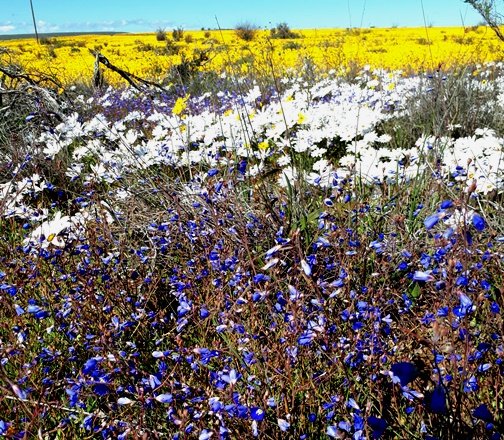Flag on a field

Author: Ivan Lätti
Photographer: Ivan Lätti
Daisies and sporrie growing in allocated neighbourhoods, separated by nature, may yield a tricolor design that could be chosen by some new nation as its flag. Unicolour patches as well as thoroughly mixed flower fields do occur in the Namaqualand spring countryside. Natural rules and chance factors apply in the continual becoming of microecologies and their constituents.
Next year the seeds of these flowers may grow in an entirely different overall pattern. Even the plants undergo appearance differences in their successive generations. Every species has ragged, changeable perimeters, its later born specimens including the unexpected, deviating from even the most frequently repeated forms of the past. It’s the continual adapt or die game played by all living things.
Flowers of a kind given a particular, well-remembered name like rose is a useful mental construct in the reality shaped by people for daily use, irrelevant in the world of real roses blooming and dying. The notion and especially the formal description or definition of a plant species is not real in nature, not part of nature.
It remains a convenient human construct for understanding a particular (generalisation about a) known plant. Patterns in plant appearance, their evolutionary development and ecological roles reflect the life of a plant type over time, its journey of becoming, not only for the individual, but also for its species, genus and family.
Phenology is the study of cyclic and seasonal natural phenomena in relation to the life cycle of the individual plant (or other living entity). The fixed concepts held in human minds about living things serve as tools of study and summarising the fruits of learning. Natural diversity does not comply with its models, it’s the other way round: simplified or static patterns that people use to characterise species have to be corrected continually for fitting their objects of study.
Human mental abstractions describe, compare and label, grow in the reality of the mind. People forget that the plant is followed by the book, not led by it. The studied targets grow independently in their all too real world of life and death, continually challenging what people know and believe about them. Life challenges its stereotypes.

